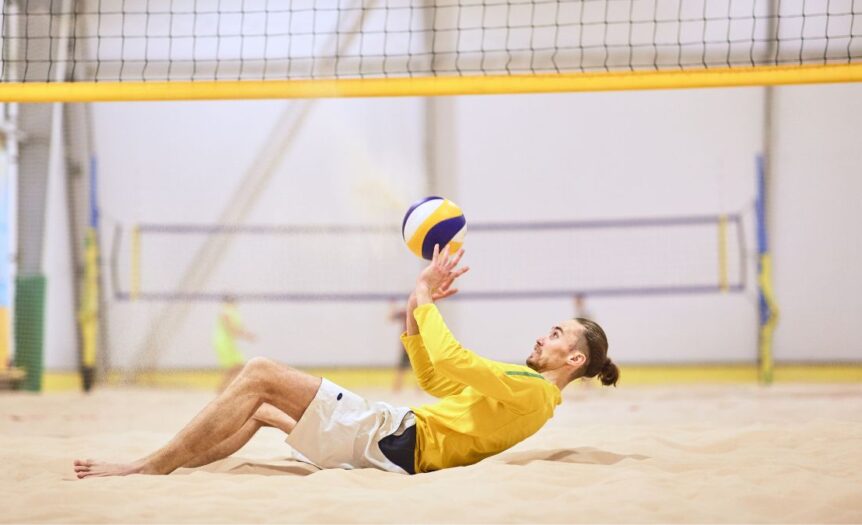It’s no secret that athletes are dedicated to their sport, and consistent practice is a part of staying sharp. However, beach volleyball players are at a bit of a disadvantage, as weather changes make outdoor sand courts temporarily unavailable. They could practice on a regular indoor court, but learning to move on the sand is critical. If you want to give athletes the facilities they need and make long-term customers, learn how to build an indoor volleyball sand court.
Finding a Facility
Your first job is to find a space to host an indoor court, which must be at least 23 feet tall. The size of the facility depends on the type of courts you want to set up and how many you want to include. Remember that you’ll need at least three to host official events, and the dimensions of recreational and competition courts differ.
If you’re struggling to find a facility that meets these requirements or don’t want to have to pay rent in perpetuity, installing a fabric structure over your outdoor court may be the best option. One of the main components of a fabric structure is its membrane, which is typically built to block UV rays and withstand harsh weather.
Dimensions and Configuration
In terms of configuration, you don’t have to worry about which direction your court is facing because the sun won’t minimize visibility indoors. However, all official courts should be 16 by 8 meters. Women’s nets should be 2.24 meters high, and men’s nets should be 2.43 meters high. Clearance space differs depending on the competition level. Clearance space for juniors should be 3 meters, collegiate 4.5 meters, and professionals 6 meters.
Dig, Frame, and Fill Your Court
Your next job is to determine whether you want your court to be in-ground or above-ground. An above-ground court should be about 1.5 feet deep, while an in-ground should be 3 feet. If you’re working with a pre-built facility, you likely won’t have a choice, but you will need to deepen the flooring. Before you start filling in your sand, you must frame your court with anchored poles, ideally with aluminum or stainless steel.
Fortunately, you don’t have to worry about sand drainage for an indoor facility, but you still have to consider the quality of your sand. If you want to build a quality indoor volleyball sand court, the sand itself should be gravel free so athletes don’t scrape themselves while sliding, and it should produce minimal dust. Remember, once the court is filled, your poles should be padded and free of guy wires.
Final Set Up
Once you’re done framing and filling your court, you can set up your boundary lines and hang the net. Regardless of whether you plan to host official events, you at least need locker rooms and a seating area so athletes can relax and cool down. If you want to host events, you’ll have to ensure plenty of room outside the clearance space to provide seating for spectators. When everything’s set up and ready to go, you can open your doors with confidence and get ready to see some very happy athletes.










 Deering Estate
Deering Estate
 Massage Envy South Miami
Massage Envy South Miami
 Calla Blow Dry
Calla Blow Dry
 My Derma Clinic
My Derma Clinic
 Sushi Maki
Sushi Maki
 Sports Grill
Sports Grill
 The Healthy Kitchen
The Healthy Kitchen
 Golden Rule Seafood
Golden Rule Seafood
 Malanga Cuban Café
Malanga Cuban Café

 Kathleen Ballard
Kathleen Ballard
 Panter, Panter & Sampedro
Panter, Panter & Sampedro
 Vintage Liquors
Vintage Liquors
 The Dog from Ipanema
The Dog from Ipanema
 Rubinstein Family Chiropractic
Rubinstein Family Chiropractic
 Your Pet’s Best
Your Pet’s Best
 Indigo Republic
Indigo Republic




 ATR Luxury Homes
ATR Luxury Homes


 2112 Design Studio
2112 Design Studio
 Hamilton Fox & Company
Hamilton Fox & Company
 Creative Design Services
Creative Design Services
 Best Pest Professionals
Best Pest Professionals
 HD Tree Services
HD Tree Services
 Trinity Air Conditioning Company
Trinity Air Conditioning Company
 Cisca Construction & Development
Cisca Construction & Development
 Mosquito Joe
Mosquito Joe
 Cutler Bay Solar Solutions
Cutler Bay Solar Solutions


 Miami Royal Ballet & Dance
Miami Royal Ballet & Dance
 Christopher Columbus
Christopher Columbus
 Pineview Preschools
Pineview Preschools
 Westminster
Westminster
 Carrollton
Carrollton
 Lil’ Jungle
Lil’ Jungle
 Frost Science Museum
Frost Science Museum
 Palmer Trinity School
Palmer Trinity School
 South Florida Music
South Florida Music
 Pinecrest Orthodontics
Pinecrest Orthodontics
 Dr. Bob Pediatric Dentist
Dr. Bob Pediatric Dentist
 d.pediatrics
d.pediatrics
 South Miami Women’s Health
South Miami Women’s Health

 The Spot Barbershop
The Spot Barbershop
 My Derma Clinic
My Derma Clinic




 Miami Dance Project
Miami Dance Project

 Rubinstein Family Chiropractic
Rubinstein Family Chiropractic
 Indigo Republic
Indigo Republic

 Safes Universe
Safes Universe
 Vintage Liquors
Vintage Liquors
 Evenings Delight
Evenings Delight





 Atchana’s Homegrown Thai
Atchana’s Homegrown Thai
 Baptist Health South Florida
Baptist Health South Florida

 Laser Eye Center of Miami
Laser Eye Center of Miami
 Visiting Angels
Visiting Angels
 OpusCare of South Florida
OpusCare of South Florida

 Your Pet’s Best
Your Pet’s Best





 HD Tree Services
HD Tree Services
 Hamilton Fox & Company
Hamilton Fox & Company


 Creative Design Services
Creative Design Services